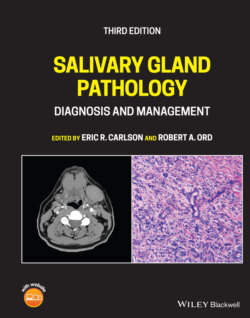Читать книгу Salivary Gland Pathology - Группа авторов - Страница 136
Summary
ОглавлениеSialadenitis is an infection of salivary glands that has numerous etiologies including microorganisms, and autoimmune diseases.
Staphylococcal and streptococcal species are involved in community acquired acute bacterial parotitis, and Pseudomonas, Klebsiella, Prevotella, Fusobacterium, Haemophilus, and Proteus species are cultured from hospital acquired cases of acute bacterial parotitis. Methicillin‐resistant Staphylococcus aureus may be cultured from cases of community acquired and hospital acquired acute bacterial parotitis.
The clinician must rule out a neoplastic process in a prompt fashion while diagnosing and treating the sialadenitis.
The presence of a sialolith must be considered in the initial workup of patients with a clinical diagnosis of sialadenitis. A screening panoramic radiograph or occlusal radiograph should be obtained. If identified, the expedient removal of a sialolith may permit functional recovery of the salivary gland.
The parotid and submandibular glands are the most commonly affected salivary glands by sialadenitis.
The purpose of initial treatment for sialadenitis is to provide medical therapy for the disorder, with surgical therapy being introduced if the disorder becomes refractory to medical treatment.
Minimally invasive strategies have a role to play in the surgical treatment of sialadenitis, as well as surgical removal of the salivary gland.
Sialadenitis in pregnant women is a clinical diagnosis worthy of expert consultation in terms of acquiring special imaging studies and initiating antibiotic therapy.
